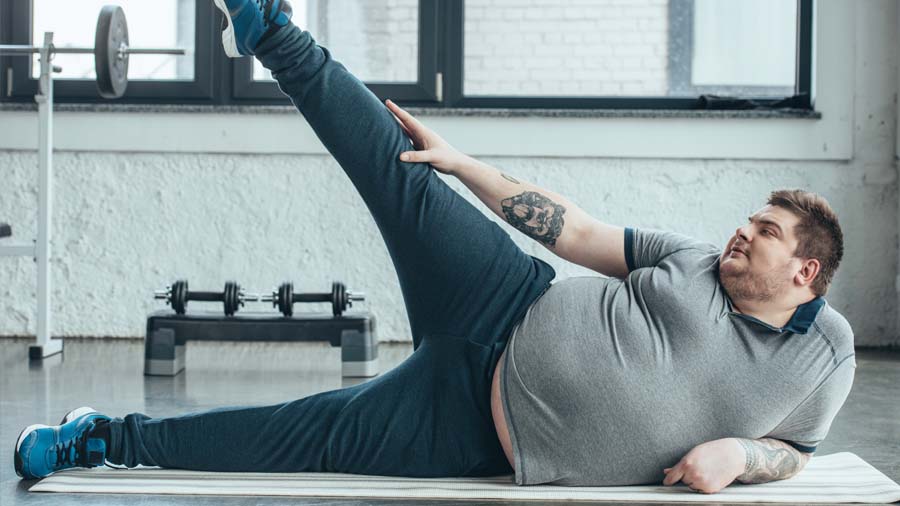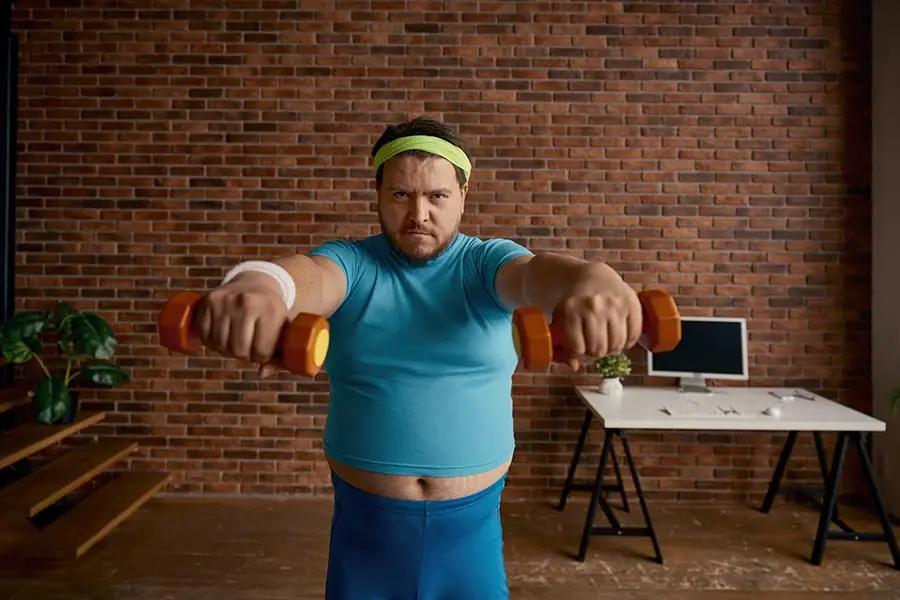Now Reading: How to Start Working Out When You’re Out of Shape (or Overwhelmed)
-
01
How to Start Working Out When You’re Out of Shape (or Overwhelmed)
How to Start Working Out When You’re Out of Shape (or Overwhelmed)

By Good Day, Good Health
It’s been a while.
Your gym shoes are buried somewhere in the closet. Your workout clothes? Still tagged. The thought of running, lifting, or joining a class makes you wince. Not because you don’t want to be healthy—but because you’re not sure where to start.
You’ve seen the fitness influencers. The green smoothies. The perfectly coordinated activewear. The ten-minute ab workouts that somehow look like an Olympic event.
Meanwhile, just the idea of walking up a flight of stairs feels like a workout. And if you’ve been through stress, illness, caregiving, weight gain, trauma, or simply life, the pressure to “bounce back” or “get it together” can feel suffocating.
But here’s what no one tells you loud enough: You don’t need to be fit to begin. You don’t need the perfect plan. You don’t need the best gear. And you certainly don’t need to compare yourself to anyone else.
You just need a body, a little breath, and the courage to take one small step.
This article is for the restarters, the beginners, the “I’ve tried before” crew, and the quietly determined. Whether you’re out of shape, overwhelmed, or unsure where to begin, this guide will walk with you—gently, honestly, and without judgment—back into your body and toward a more energized life.
The Real Reason It’s So Hard to Start (And Why That’s Okay)
We tend to think the hardest part of working out is the push-ups, the planks, or the pain. But often, the real hurdle is mental.
When you’ve been inactive for a while, starting again can feel like standing at the bottom of a steep mountain. You remember who you used to be—how strong, fast, or disciplined you once were—and the gap between then and now can feel defeating.
On top of that, the modern fitness industry doesn’t always make space for the true beginner. Many programs assume you already know the lingo, the equipment, the routine. And let’s not ignore the emotional baggage: shame, fear of being judged, body image struggles, or chronic self-doubt.
So if you’ve ever thought:
- “I don’t even know where to start.”
- “I’m too far gone.”
- “I’m embarrassed by how out of shape I am.”
- “What if I fail again?”
You’re not alone.
And none of those thoughts disqualify you from starting.
Redefining What Counts As Exercise
Forget everything you think a “real workout” is supposed to look like.
You don’t need to sweat through your clothes, collapse in exhaustion, or burn a thousand calories to make it count.
Exercise is any movement that gets your body out of stillness and into motion.
That includes:
- A slow walk around the block.
- A 10-minute stretch in your living room.
- A dance party in your kitchen.
- Cleaning your house with purpose.
- Sitting and standing from a chair, repeatedly, to build leg strength.
It all counts. Every step. Every breath. Every choice to move instead of stay stuck.
And the best workout is the one you’ll actually do—consistently, not perfectly.
Start With Where You Are—Literally and Physically
You don’t need a gym membership, fancy equipment, or a three-month plan. You just need to begin.
Ask yourself:
- What feels possible today—not ideal, but possible?
- Can I commit to moving for 5 minutes?
- Can I stretch during TV commercials?
- Can I walk while taking a phone call?
The key is to remove as many obstacles as possible. Start in your home, your yard, your hallway. Start in your PJs, in your slippers, barefoot on your rug.
Just start somewhere.
Set Ridiculously Small Goals
In the beginning, motivation doesn’t come from massive progress—it comes from small wins.
Try setting micro-goals that feel almost laughably doable:
- 3 minutes of movement per day
- 5 push-ups against the wall
- 1 walk to the mailbox and back
- 10 bodyweight squats
- One song’s worth of dancing
These small actions compound. They help rebuild trust between your brain and your body. They remind you that you can move, you can commit, and you are capable.
Remember: You don’t need to finish a marathon. You just need to take the first step.
The Magic of “Movement Stacking”
Here’s a secret for those who are busy, tired, or distracted: you don’t have to do your workout all at once.
Try movement stacking, which breaks exercise into small blocks throughout the day:
- 5 minutes of stretching when you wake up
- 5 minutes of strength moves during lunch
- 5 minutes of walking after dinner
That’s 15 minutes—and it adds up fast.
Don’t underestimate the power of consistency over intensity. A little bit, done often, beats a lot done rarely.
Shift from “Punishment” to “Partnership”
If exercise feels like punishment for gaining weight, aging, or being sedentary, it’s time to rewrite the narrative.
Your body isn’t the enemy. It’s not broken. It’s not shameful. It’s been through things. And the fact that it’s still here—carrying you, breathing for you, waking up each morning—is a miracle.
Working out isn’t about fixing your body—it’s about reconnecting with it.
So move because you love your body, not because you’re mad at it. Move to feel stronger, clearer, more alive—not to earn food, approval, or rest.
Healing starts when movement becomes partnership instead of punishment.
Don’t Wait for Motivation—Build a Routine
If you’re waiting to “feel like it,” you may wait forever.
Motivation is fleeting. What matters is momentum.
Instead, focus on creating a routine that makes movement a normal, daily part of life.
Try:
- Setting a recurring reminder on your phone
- Laying out your workout clothes the night before
- Starting your day with a stretch or short walk
- Linking movement to another habit (i.e., “After I brush my teeth, I do 5 squats”)
You don’t need willpower. You need a system.
What Kind of Exercise Should You Do?
There’s no one-size-fits-all. Choose something that feels safe, fun, and achievable right now.
Here are great options for true beginners:
1. Walking
Simple, low-impact, accessible. Start with 5–10 minutes and build up. Use a podcast or playlist for company.
2. Chair Workouts
Yes, chair workouts! They’re great for mobility, injury recovery, or anyone easing back in. YouTube has dozens of options.
3. Low-Impact Cardio
No jumping, no stress on the joints—just movement to elevate your heart rate gently.
4. Resistance Bands
Great for strength training without weights. Start with basic moves and light resistance.
5. Bodyweight Exercises
Squats, wall push-ups, step-ups—no equipment needed. Just gravity and grit.
6. Stretching or Mobility Work
Not only does this improve flexibility, but it also reduces stress and tension stored in the body.
Don’t worry about being “good” at any of it. The win is in the doing.
Dealing With the Emotional Side of Starting
Starting a workout journey often stirs up old wounds: past failures, shame, comparisons, fear of judgment.
If you’ve ever:
- Been made fun of in a fitness space
- Felt out of place in a gym
- Tried and “failed” before
- Battled with your body image
…then be gentle with yourself.
You’re not broken. You’re healing. And every bit of movement is a step toward reclaiming your power.
It’s okay to cry during a stretch. It’s okay to feel frustrated. Let those emotions move through you, not stop you.
Your healing is happening. Let it.
What If You Miss a Day (or a Week)?
You will.
Because life happens. Illness, fatigue, grief, holidays, work—whatever it is, it’s okay.
Missing a workout doesn’t mean starting over. It means continuing.
You didn’t fail. You’re human. And every new day is another chance to move forward.
Use Tools That Encourage You—Not Shame You
There are plenty of tools to support your comeback, but choose wisely.
Try:
- Apps like Daily Burn, Grow With Jo, or Seven for beginner workouts
- YouTube channels with “beginner,” “low-impact,” or “no equipment” in the title
- GDGH Connect for community support, workout tips, and inspiration
Avoid tools that trigger guilt, comparison, or toxic “no pain, no gain” mindsets. You deserve encouragement—not pressure.
Celebrate Every Tiny Victory
- First 5-minute walk? Celebrate.
- First time stretching without pain? Celebrate.
- Showed up even when you didn’t want to? Celebrate.
Progress isn’t always visible. It’s in the moments you choose to keep going. A body in motion is a victory—no matter how slow the start.
You Don’t Have to Do This Alone
One of the best ways to stay consistent is to connect. Find a friend to walk with. Join an online accountability group. Follow creators who show real, slow, imperfect fitness journeys.
At Good Day, Good Health, we believe community fuels change. You’re not meant to grind alone. You’re meant to grow with support.
Final Word: You Belong Here
Fitness isn’t reserved for the young, the lean, or the already active. It’s for everyone—including you, right now, in whatever body you’re in.
You belong in movement. You belong in wellness. You belong in your body.
Forget the trends. Forget the pressure. Forget the comparison.
Just start—with one step, one breath, one moment of motion.
You don’t have to get it perfect. You just have to get it going.
Let Good Day, Good Health support you every step of the way.
Explore beginner-friendly resources, join a movement challenge, or meet others just like you on Good Day, Good Health. We’re building a wellness space where real people start where they are—and never give up.
Because starting over doesn’t mean starting from scratch.
It means starting with wisdom, with experience, and with heart.
And we’ll be here cheering you on the whole way.



